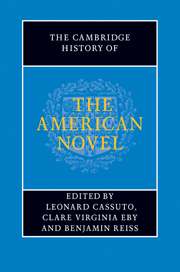Book contents
- Frontmatter
- General Introduction
- PART ONE INVENTING THE AMERICAN NOVEL
- PART TWO REALISM, PROTEST, ACCOMMODATION
- Introduction: realism, protest, accommodation
- 17 Realism and radicalism: the school of Howells
- 18 James, pragmatism, and the realist ideal
- 19 Theories of the American novel in the age of realism
- 20 The novel in postbellum print culture
- 21 Twain, class, and the Gilded Age
- 22 Dreiser and the city
- 23 Novels of civic protest
- 24 Novels of American business, industry, and consumerism
- 25 New Americans and the immigrant novel
- 26 Cather and the regional imagination
- 27 Wharton, marriage, and the New Woman
- 28 The postbellum race novel
- 29 The African American novel after Reconstruction
- 30 The rise of naturalism
- 31 Imagining the frontier
- 32 Imperialism, Orientalism, and empire
- 33 The hemispheric novel in the post-revolutionary era
- 34 The woman's novel beyond sentimentalism
- 35 Dime novels and the rise of mass-market genres
- 36 Readers and reading groups
- PART THREE MODERNISM AND BEYOND
- PART FOUR CONTEMPORARY FORMATIONS
- A selected bibliography
- Index
35 - Dime novels and the rise of mass-market genres
from PART TWO - REALISM, PROTEST, ACCOMMODATION
Published online by Cambridge University Press: 28 July 2011
- Frontmatter
- General Introduction
- PART ONE INVENTING THE AMERICAN NOVEL
- PART TWO REALISM, PROTEST, ACCOMMODATION
- Introduction: realism, protest, accommodation
- 17 Realism and radicalism: the school of Howells
- 18 James, pragmatism, and the realist ideal
- 19 Theories of the American novel in the age of realism
- 20 The novel in postbellum print culture
- 21 Twain, class, and the Gilded Age
- 22 Dreiser and the city
- 23 Novels of civic protest
- 24 Novels of American business, industry, and consumerism
- 25 New Americans and the immigrant novel
- 26 Cather and the regional imagination
- 27 Wharton, marriage, and the New Woman
- 28 The postbellum race novel
- 29 The African American novel after Reconstruction
- 30 The rise of naturalism
- 31 Imagining the frontier
- 32 Imperialism, Orientalism, and empire
- 33 The hemispheric novel in the post-revolutionary era
- 34 The woman's novel beyond sentimentalism
- 35 Dime novels and the rise of mass-market genres
- 36 Readers and reading groups
- PART THREE MODERNISM AND BEYOND
- PART FOUR CONTEMPORARY FORMATIONS
- A selected bibliography
- Index
Summary
Written and marketed for a wide audience, dime novels are often remembered as escapist formula fiction for boys that presented few opportunities for authorial innovation. A longer history of the dime novel, however, complicates this memory by revealing an immense body of popular literature, written and read by both women and men, which mediated the conflicts of its era in diverse ways rather than ignoring them. Many dime novel authors started out as contributors to the story papers and other periodicals that emerged in the wake of the late 1840s print revolution. In the first dime novels of the 1860s, they adapted familiar genres, including captivity and seduction narratives; stories of scouts, white settlers, and Indian fighting; mysteries of the city; historical and international romances; and pirate, crime, and war stories. These genres, along with new ones, flourished in the last part of the dime novel's heyday, when the production of cheap literature more closely resembled the fiction factories of dominant memory. This last era witnessed a transformation in the meaning of authorship as characters became trademarks owned by publishing companies, which also controlled house names such as Bertha M. Clay, under which Street and Smith published the stories of several different writers. The publishers and editors of this period often came up with titles, characters, and plots and then asked authors, who were poorly paid and had to write very quickly, to invent stories based on those ideas, thereby making the dime novel a more standardized literary commodity.
- Type
- Chapter
- Information
- The Cambridge History of the American Novel , pp. 586 - 599Publisher: Cambridge University PressPrint publication year: 2011
- 2
- Cited by

